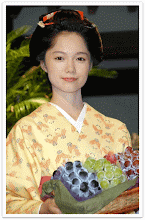Gagaku is the Sacred court Music of Japan whose history dates back some 1300 years. It is a cultural treasure that is still with us today as the oldest surviving and rarest continuous orchestral music in existence today. As that being said, this music had been confined to the Imperial Court and had we lived 170 years ago in Japan Costa Mesa California
So going back to the performance, the first segment of the Gagaku performance was entitled “The Classical Sounds of Gagaku Music” The second conclusive segment was aptly named “Contemporary Music for Gagaku Instruments.” Performing on stage was master musicians Takeshi Sasamoto on Ryūteki, Hitomi Nakamura on Hichiriki, and Mayumi Miyata on Shō or as translated as the “Phoenix pipe.” Each performer appeared in traditional garments of the Imperial Court for the first segment and instantly mesmerized the audience in attendance with the haunting sounds of the shō. This continued on well into the second segment when the musicians returned in modern clothing to express their free form almost jazz like use of Gagaku instruments in the most unique and entertaining sounds. I must admit I was quite taken by the sounds of the shō. It is impossible to conceive of this keyboard sounding instrument that is a wind blown driven pipe could have existed some 1300 years ago. It is very fitting for Shinto weddings, funerals, and Imperial Installations. But is also something as I will alude to in my last paragarah very relevant to what has been taking place in the wake of Japan's worst disaster in modern history since the end of WWII.
Gagaku is as timeless as it a national treasure. It has endured over the centuries under strict adherence to traditions of the Imperial Court. But sometime during the early 1970’s it was realized that these very restrictions meant to preserve the sacred music were endangering Gagaku to extinction. In fact up until the 1960’s it was considered heresy to even think of creating new pieces for Gagaku. It was said then that Gagaku in its rigid preservation could suffer the fate of the butterfly pinned to a collection for safe keeping. This would not be enough to keep the art alive. For this reason a new thinking was employed and gradual experimentation was given to Gagaku performers particularly to Sukeyasu Shiba of the Imperial Household Agency to utilize Gagaku unique instruments in exploratory fashion to keep Gagaku from dying. As a result new pieces have been composed and performed in ways earlier Gagaku musicians could have never dreamed of. Since then, Gagaku has found new interest and is said to be even an elective in schools as a musical course which has resulted in Gagaku clubs forming in and around Tokyo
This rare Gagaku performance which was presented by the Philharmonic Society in conjunction with JapanOC had been planned months in advance. But with the extraordinary events that culminated in the combined disasters in Japan, the concert took a more somber tone as to reflect on those lives lost and those still missing. This real life drama painted a deeper picture to what was already a transformative performance that is best experienced least described. As with many other Japanese events taking place during this time, a plea for donations for the relief efforts in Japan was called for the audiences generosity. What better music to stir the soul during times of need. We would like to thank JapanOC and the Philharmonic Society for their efforts for the People of Japan.






















No comments:
Post a Comment